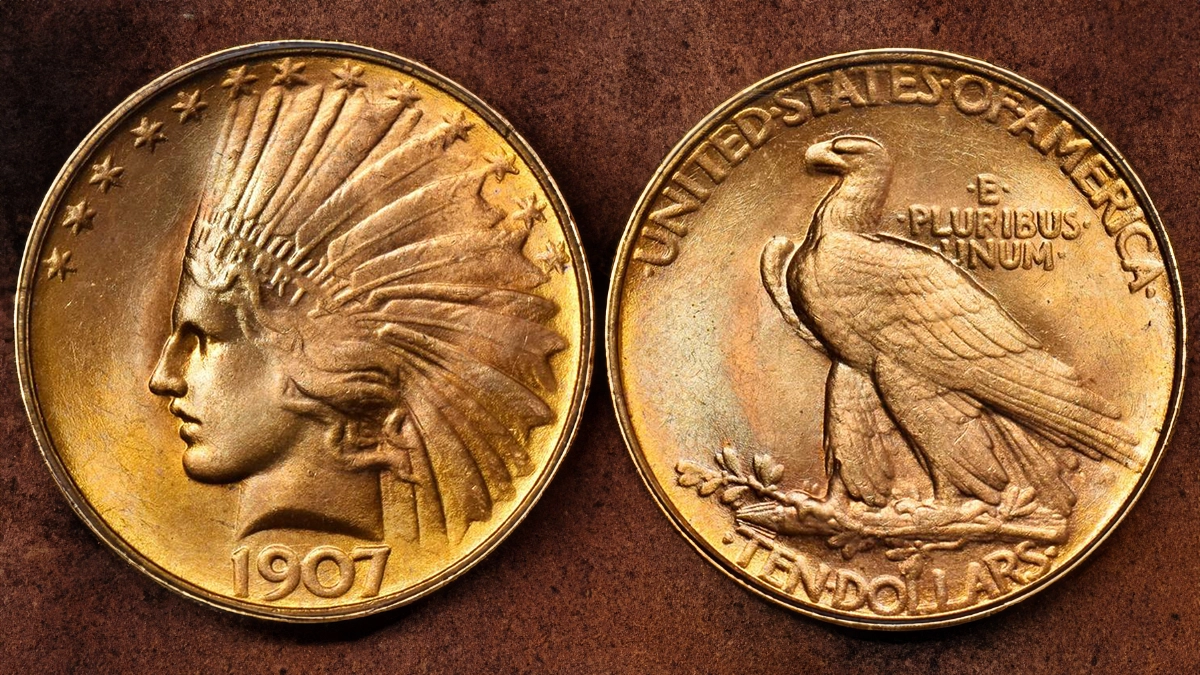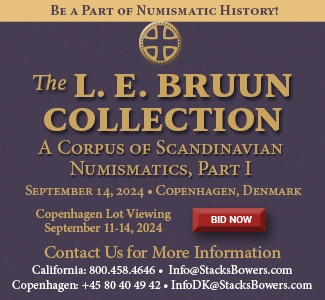
By Charles Morgan and Hubert Walker for CoinWeek Notes …..
It’s amazing that two of the most celebrated American coin designs–the Indian Head $10 Eagle and Saint-Gaudens $20 Double Eagle–ever got made. Neither would live up to Augustus Saint-Gaudens’ expectations, but the master artist devoted the last few months of his life to the effort, working with President Theodore Roosevelt on what the latter called his “pet crime.”
The Beaux Arts sculptural style of Liberty wearing an Indian headdress was inspired by James Barton Longacre’s Indian Head Cent, its sculptural detail and beauty elevated. The female figure was modeled after the goddess Nike (representing Victory) that Saint-Gaudens depicted as part of his Sherman Monument at the entrance to New York’s Central Park.
Final revisions of the production coin were carried out by Saint-Gaudens’ assistant Henry Hering and United States Mint Chief Engraver Charles E. Barber. Barber is often criticized for reducing the original ultra-high-relief designs to caricatures, but even today’s Mint technology would be incapable of producing the original design in volume. Furthermore, technical modifications were required to allow the coins to stack and to preserve the life of the dies.
In the first two years of release, the Indian Head Eagle did not display the motto IN GOD WE TRUST. That phrase appeared on the previous Liberty Head Eagle and was mandated by the Act of March 3, 1865, but was left off Saint-Gaudens’ design. Public blowback to this omission was swift and Congress resolved that the motto be placed back on the $10 gold coin. The motto was added to the reverse for issues produced starting midway through 1908.
The original coinage of 1907 Wire Rim With Periods Indian Head Eagles is not known. Contemporary figures vary slightly, but totals of 500 to 550 are often cited, with the 500 figure now in favor. It is estimated that perhaps 325 to 375 of this type survive. All have semi-lustrous surfaces and a finish like a hybrid between matte and mint frost.
Why Is the 1907 Indian Head Eagle, With Periods and No Motto Important?
The importance of this coin is recognized thusly by numismatist Walter Breen in his 1988 Encyclopedia:
“The very first of these [the wire rim issue] are the only available gold $10s showing the Saint-Gaudens’ conception in anywhere near their pristine splendor.”
All specimens are from the same pair of dies, and under magnification one can see a multitude of tiny swirls or raised die finish lines. The motif differs from the circulation issue in that there are raised periods before and after the reverse inscriptions.
Two versions of the rim are noted. Numismatists refer to these as the Wire Rim and the Rolled Edge.
On the Wire Rim version (sometimes called the “Knife Rim”), the rim is raised or sharp. More appropriately called a rim, the type is sometimes called a Wire Edge. There is some debate about whether these are circulation strikes, Proofs, or patterns. They are all one or the other. The Guide Book of United States Coins (the Red Book) lists them as circulation strikes. Five hundred and forty-two were struck and 70 were reportedly melted in 1914-1915. Far more Rolled Edge coins were minted, and, were it not for the fact that all but 50 were culled, these would be more accessible than the Knife Rim. Fewer than 50 are accounted for today and examples are prohibitively expensive in all grades.
* * *
Market Data and Noteworthy Specimens
1907 Indian Head Eagle – No Motto With Periods Rolled Edge
Top Population: PCGS MS67+ (1, 9/2024), NGC MS67+ (1, 9/2024), and CAC MS67 (2:0 stickered:graded, 9/2024).
- NGC PF67 Satin #3314588-004: Mint Director Frank A. Leach; Florence Leach; Colonel George Monroe; “The Colonel George M. Monroe Collection,” Heritage Auctions, January 6, 2011, Lot 5238 – $2,185,000.
- PCGS MS67 CAC #500009218: Dr. Paul and Rosalie Zito, March 18, 2003; “The Dr. Paul and Rosalie Zito Collection,” Stack’s Bowers, April 5, 2022, Lot 4059 – $1,140,000.
- PCGS MS67 CAC #38634098: “The D. Brent Pogue Collection, Part VII” Stack’s Bowers, March 20, 2020, Lot 7343 – $576,000.
- PCGS MS67 #27399444: “The Kutasi Collection,” Heritage Auctions, January 2007, Lot 3160; “The Bentley Shores Collection,” Stacks Bowers, August 14, 2013, Lot 4524 – $470,000.
- PCGS MS67 #22055768: “The Kutasi Collection,” Heritage Auctions, January 4, 2007, Lot 3160 – $402,500; “The Madison Collection,” Heritage Auctions, January 10, 2008, Lot 3271 – $460,000.
- NGC MS66+ CAC #4253892-001: Heritage Auctions, August 10, 2016, Lot 4320 – $346,625.
- PCGS MS66 #45371677: “The Mocatta Collection,” Stack’s Bowers, August 25, 2022, Lot 7188 – $576,000.
- PCGS MS66 #4867251: “The Cody Brady Collection, Part IV,” Heritage Auctions, July 14, 2022, Lot 3345 – $810,000.
1907 Indian Head Eagle – No Motto With Periods Wire Rim
Top Population: PCGS MS67+ (1, 9/2024), NGC MS69 (1, 9/2024), and CAC MS67 (3:0 stickered:graded, 9/2024).
- NGC MS68 #552700-003: Dr. Paul and Rosalie Zito, June 29, 1998; “The Dr. Paul and Rosalie Zito Collection,” Stack’s Bowers, April 5, 2022, Lot 4058 – $840,000.
- NGC MS68 #1770775-001: “The Joan Zieg Steinbrenner Collection,” Heritage Auctions, August 14, 2019, Lot 3911 – $432,000.
- NGC MS67+ CAC #4155614-001: Heritage Auctions, August 16, 2018, Lot 5286 – $312,000.
- PCGS MS67 #06644154: Heritage Auctions, July 14, 2022, Lot 3344 – $336,000.
* * *
Design
Obverse:
Liberty faces left on the obverse, wearing a many-feathered bonnet that displays the word LIBERTY across the front. Strands of flowing hair appear below the headdress at the forehead and across the side to the back. Thirteen six-pointed stars form an arc inside the top third of the raised rim above and slightly touching the feathers of the headdress. The date 1907 is centered counterclockwise at the bottom, crowding the portrait and the rim.
Reverse:
A majestic eagle faces left and rests on a bundle of arrows with an olive branch intertwined. Inside the raised rim is the legend UNITED STATES OF AMERICA at the top and the denomination TEN DOLLARS at the bottom, the words of both inscriptions separated by centered, somewhat triangular dots. At the upper right, above but touching the eagle and below OF AMERICA, is the motto E PLURIBUS UNUM, each word on a separate line. Interpuncts or periods border each line and each phrase.
Edge:
The edge of the Indian Head Eagle, No Motto $10 gold coin is starred, with 46 raised stars.
Coin Specifications
| Indian Head Eagle, No Motto With Periods | |
| Year of Issue: | 1907 |
| Mintmark: | None (Philadelphia) |
| Mintage: | Wire Rim: 542 (70 melted in 1914-15); Rolled Edge: 32,500 (all but 50 melted) |
| Alloy: | .900 gold, .100 copper |
| Weight: | 16.7 g |
| Diameter: | 26.8 mm |
| Edge: | Starred |
| OBV Designer: | Augustus Saint-Gaudens |
| REV Designer: | Augustus Saint-Gaudens |
* * *



